Chain mail appeared in a couple different forms during World War I – the most well-known is probably the mail facemasks developed for tank crews. These were intended to protect crew members from steel shards that would fragment off the interior of the tank’s armor plate when taking machine gun fire. There were also metal-lined jackets made (and advertised as being bulletproof), although these were really closer to scale mail than chain mail. But I digress…
A while back, I bought a whole bunch of magazines as a lot from Rock Island Auctions. Included in the lot was a rather odd leather and chain mail…thing. It seems to be quite well made, but has no markings at all that I can find. I had no idea what it was, and it didn’t fit any military pattern I was aware of. I decided it was some sort of homemade SCA-type thing – the strap and buckle were the right length to fit around the waist, so I guessed that it was a groin protector.
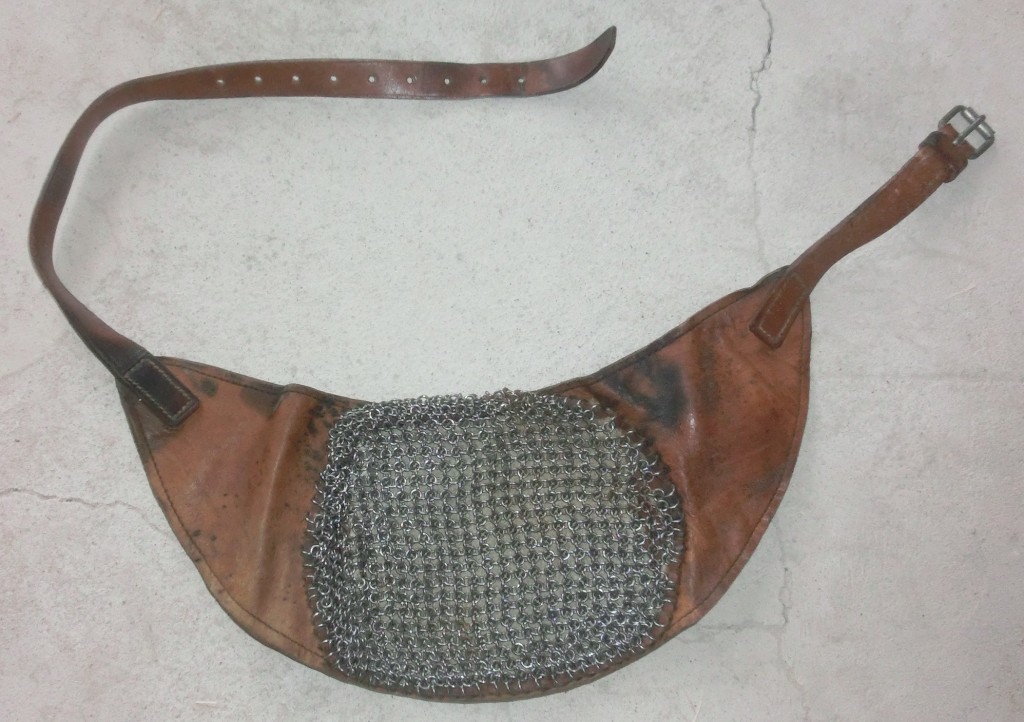
And I was completely wrong.
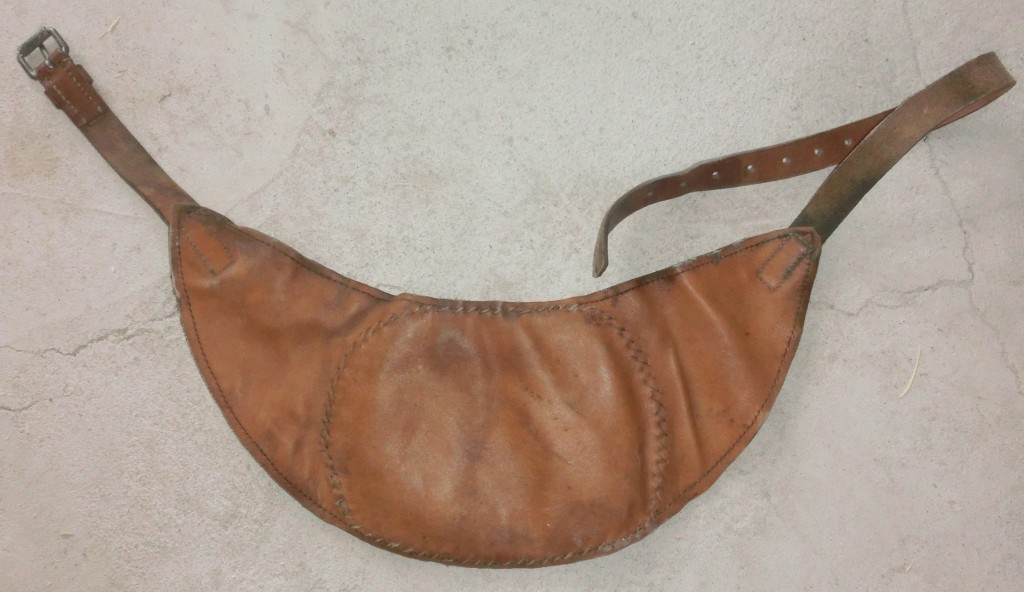
It recently came to my attention that chain mail accessories were apparently made for US troops using Hotchkiss machine guns. I see them referenced for both the 1914 heavy Hotchkiss and the lighter Portative, and have not been able to find any primary source references specifying which gun they were intended for. The items were mittens for changing hot barrels, and shoulder pads for carrying hot guns. What I had purchased is in fact a shoulder pad – it sits atop the shoulder, and the strap goes across the chest and under the opposite arm, buckling on the back. This will allow one to rest the hot barrel of a gun on the shoulder without burning oneself.
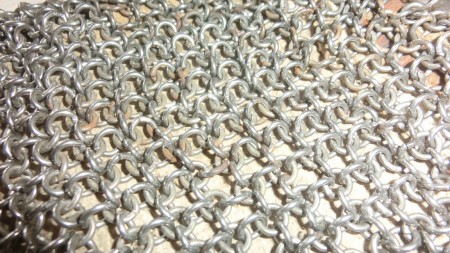
The construction, on closer inspection, is two layers of leather, then an asbestos pad, and then the chain mail on top. While I haven’t tried it out myself with a hot gun, it does fit well and appears to be both very sturdy and very effective at protecting a person from the heat of a gun barrel. From looking at a few photos online, the mittens appear to have used the same multi-layered design. One can’t help but think that the US Army was still using this concept in the 1960s with the asbestos glove issued for changing M60 barrels…
For what it’s worth, I was unable to find reference to these accessories in any of the 13 different Hotchkiss manuals I have copies of – if anyone knows more about these (who they were issued to, which type of Hotchkiss, what time period, etc) I would be very interested in learning more…

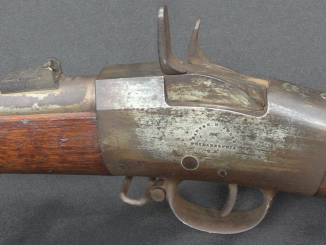
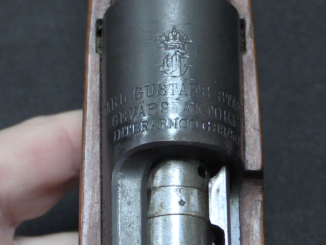
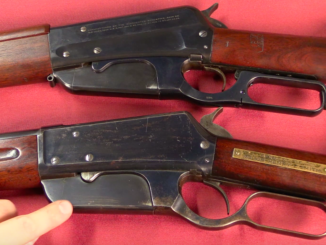
The structure is very similar to early medieval mail,which was intended to protect against the cut of a sword. The “offensive” response was the poigniard, or dagger, with a slender blade that could slip through the mail’s rings. The purpose being to convince the captive to come across with a hefty ransom.
Later mail had a different pattern of ring “tessellation” linking, that eliminated the rings that were edge-on, giving a closer-meshed mail and thereby reducing the chances of something “slipping through”.
I’ve read (notably in the works of Kenneth Macksey) that the mail “face curtains” used by tank crews weren’t very effective against splinters, etc. If they were the same “semi-open” weave pattern as this mail, I’m not a bit surprised.
cheers
eon
That would be a spectacularly ineffective groin protector, anyway.
People doing stick fighting like the SCA use athletic cups, and if they want more, usually skirting.
the pattern or weave of the chain mail is usually referred to as Japanese 4 in 1
http://www.mailleartisans.org/weaves/weavedisplay.php?key=18
and yes it does work and it is still used today in mittens that protect you from very high temperature (1000°C)
mailletec industries has some videos on their site showing someone holding red hot glowing things with there Nova Shield Welding Gloves on and they really protect your hands from the heat
http://mailletec.com/Gloves
other companies are available but they don’t have videos on their site
http://www.edc-protection.com/cloth-details/items/103.html
http://www.superiorglove.com/dragon-extreme-heavy-gauge-stainless-steel-mesh-glove
It always amazes me what tools disappear from history. It makes me wonder what tools that I commonly use will be completely lost in a hundred years, forgotten in some box in an old workshop with no documentation and no contemporaraly obvious use. Which tools do I use today, whose function I find obvious, will be enigmas to future generations?
Chain mail is used today in aprons and gloves by butchers and by certain industrial workers. I don’t know the history of this sort of safety equipment, but it’s possible that the chain mail used to make the above item (and the others mentioned) was an easily purchased commercial item. That would explain the popularity of this material in WW1 when a need came up for it.
Tanks and other armoured vehicles today usually have “anti-spall liners” made from aramid fabric (kevlar is a brand of aramid) or something similar covering the inside of the crew compartment to prevent spall fragments from injuring the crews or damaging delicate equipment.
Note that HESH ammunition was designed specially to use spall effect.
Also known as HEP or HEP-T ( High Explosive, Plastic or High Explosive, Plastic, Tracer ) in some circles.
Also note that in WW1 the internal spall was more likely than in post-WW2 tanks, because armour was riveted, so if tank was hit with artillery shell rivets break and acts as a spall inside, even if shell itself don’t penetrate.
Exactly — very good call.
I should have added that this very characteristic weighted the whole case in favor of welded armor at the time.
Hi,
It’s a carrying shoulder pad for the Hotchkiss machine gun model 1914:
http://armesfrancaises.free.fr/Mitr%20Hotchkiss%2014.html
“VI) Accessoires:
L’ensemble des accessoires et des pièces de rechanges est contenu dans plusieurs sacoches répartis entre les membres de l’équipe de pièce ou accrochés sur les voiturettes ou les bâts, cette répartition a évoluée suivant les époques, voici celle décrite dans le manuel de 1917:
1) contenu du sac à chiffons:
1 Kg de chiffons environ,
1 seau en toile,
1 épaulière pour le transport à dos d’homme,
1 paire de gants anti-chaleur pour l’échange du canon”
Translated :
VI) Accessories:
All accessories and spare parts is contained in several bags distributed among the members of the gunners team or hung on carts or saddles, this distribution has evolved according to the times, here is the one described in the manual of 1917 :
1) contents of the “rags bag”:
About 1 Kg of rags,
1 bucket canvas
1 shoulder pad for carrying on the back,
1 pair of heat resistant gloves for the exchange of gun
I would think that carrying a hot barrel on your shoulder with such a pad would be setting yourself up for facial burns if the load shifted, though perhaps a helmet would protect against such slippage.
I would imagine slinging a glowing MG onto your shoulder was only done when one had to evacuate the postion in haste, maybe shifting to fall back positions, etc. A high collar on the uniform tunic might protect from a burn as well. I wonder if the texture of the pad kept the barrel from slipping around?
Thanks for showing this; it’s an interesting bit of history that I’d certainly never heard of before.
It might interest everyone to know that the British issued a type of waistcoat to Vickers and Lewis gunners for the same reason. It was very short, only extending down to the upper chest, and had two thick shoulder pads for resting the barrel on. I had always assumed that the pads were just leather with a wool backing but having seen this I do wonder if the construction was the same.
One advantage I can see for the waistcoat is that it had a very large and thick collar which I guess was there protect the gunner’s neck if the barrel slipped. I can’t imagine that being a very pleasant experience if the protection wasn’t there.
There’s a picture of the Jacket available if anyone’s interested, for some reason posting a direct link won’t work but you should be able to see the picture in this Wikipedia article. The picture is the one of the two Vickers gunners wearing gas masks; the soldier closet to the camera is wearing one of the Jackets.
http://en.wikipedia.org/wiki/PH_helmet
At least Hotchkiss put some real forethought into the conceived usage of the shoulder pad and mitten as part of the whole gun system. On the other hand, one gets the impression that the designers of the M60 GPMG simply added the asbestos mitten for the AG as a convenient afterthought for the quick-change barrel design.
Took a closer look at the item and the stitching where the leather straps connect to the leather pad is not quite right. If a leather worker had a hand in the design the stitching would be a U shape. The rectangle shaped stitching only wastes thread and stitching time while weakening the strap. Unlike sewing cloth where the thread goes between fibers, sewing leather requires the leather to be punched through and that weakens it, and having a rectangle of stitches to attach a strap weakens the strap significantly without appreciably making a stronger bond to what it is being sewed to. That is something an American saddle maker would not do, either it was a more work = more quality mind set in France, or whoever designed it did not have experience with leather goods. But whoever designed it, they were smart enough not to use copper rivets to attach the strap, that would have been common practice back then, but it sure would have gotten hot fast if a hot barrel accidently touched one.
Isn’t asbestos dangerous to human health ?
If you breathe in the fibers, yes. In a form like this shoulder guard (or the protective wrap around a Vickers water jacket), no.
It Looks quite old, I never hear about it.
Where can I still found it?
I found 3 of these today in Verdun. Bought 1 for my hotchkiss back home.
Thank you…an associate of mine has one..now he knows what it’s for…excellent info